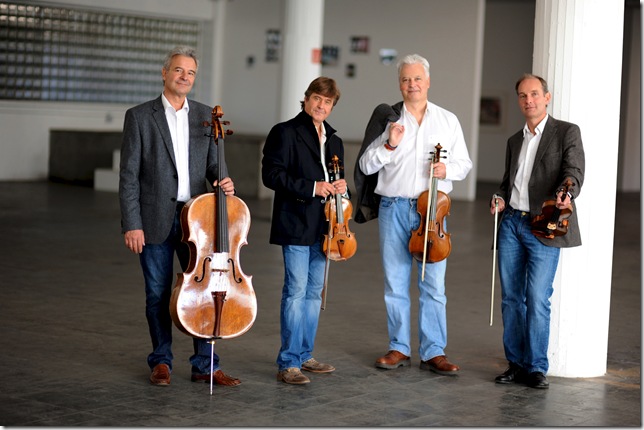After three decades of performing together in the world’s best venues, the Auryn Quartet was chosen to close the Flagler Museum Music Series on March 3.
Intentional or not, John Blades, executive director of the Flagler, left the best to last. Perhaps I ought to say the very best to last, as this was a blue-ribbon performance from beginning to end.
The Auryn, consisting of three German players and one Englishman, is based in Detmold, a delightful farming community in Germany. They teach at the Music Academy and play four rare and centuries-old Italian instruments. The first violin, Matthias Lingenfelder, plays a 1722 Stradivari; the second violinist, Jens Oppermann, a 1740 Petrus Guarneri; the viola player, Englishman Stewart Eaton uses a 1616 Amati Brothers viola and the cellist, Andreas Arndt, plays a 1692 Nicolò Amati instrument.
The Auryn opened with Joseph Haydn’s String Quartet No. 48 (in C major, Op. 64, No. 1), nicknamed “Tost” for an Esterhazy orchestra violinist, who, on leaving when their prince and benefactor died in 1790, became a wealthy businessman, commissioning six string quartets from Haydn, of which this is the first.
From the opening of the Allegro moderato the honeyed mellow sound these four players got from their old and valued instruments told us that the Auryn was a very special string quartet. This first movement is quite short, but delightful on the ear. The second-movement Minuet has a good deal of repetition, but the Auryn’s playing was even and lush.
In the third, Allegretto scherzando, there’s some lovely anchoring cello music as variations develop from each instrument. Last, some lively, witty music makes up the fugato Finale. First the cello, then the viola, followed by the first and second violins, explore this little masterpiece of a fugue which comes to a fading end; the Auryn’s playing throughout was exemplary.
Beethoven’s String Quartet No. 5 (in A major, Op. 18, No. 5) followed. Foreshadowing Schumann, this music is more sonorous and deeper than either Haydn or Mozart, whose string quartets Beethoven would painstakingly copy out to study their scores in detail. An incredibly
refined and cheerful Allegro opens with a great sense of sweep as the composer ingeniously treats his principal theme to interruptions, repetitions and extensions. Dance-like characteristics abound and the movement ends on a tiny, quiet coda. The Minuet, placed second, and not third, begins with a tune from the first violin answered by the second violin, then the cello, last the viola.
Lovely duets ensue from the first and second violins, exquisitely played. The third movement, Andante cantabile, opens with a pretty tune that’s turned into a theme and variations starting with fine subtle playing from the cello. Five similar variations follow. How well these four players blended together, sounding at times as one. The Finale has a fast carefree Mozartean opening in sonata form, marked Allegro. Despite the contrasts and jittery themes, the Auryn Quartet played superbly, making it look and sound easy.
The Auryn String Quartet’s sound continued in golden fashion as they tackled Dvořák’s Quartet No. 10 (in E-flat, Op. 51), written straddling the years 1878 and 1879. A charming melody opens the Allegro ma non troppo movement, which is overridden by lovely first-violin scales searching for some sort of closure. It’s a polka-like tune that swashbuckles around all the instruments until in the recapitulation a descending first violin brings about a calmer subject with a beautiful descending cello as the “singing” violins quietly end it.
Strummed cello notes access a folk lament known as a dumka in the second movement. The music is elegiac and leads to a furious fiery dance, unmistakable in its makeup, marked Vivace. Third movement, after a tune up, was the Andante con moto, leading off with a serene high pitched lyrical romantic theme, very open in all its lushness of sound produced by these four fine players. Alas it’s over all too soon.
A fast witty reeling dance called a skočná opens the finale. Echoes of Dvořák’s symphonic work arise here in the big sound he writes. A big fugue develops with hints of the foregone tunes in the other movements. There was brilliant playing here, with no signs of fatigue, as the Auryn’s attack remains fresh and poignant to the end with a final restatement of the skočná.
The Flagler Museum series is recorded for possible use on National Public Radio’s Performance Today programs. It’s possible that if you tune in the Auryn Quartet may have been selected. In which case, you’re in luck.
